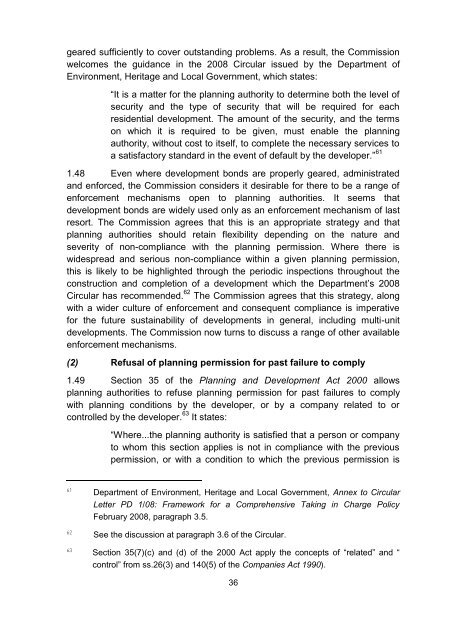Report on Multi-Unit Developments - Law Reform Commission
Report on Multi-Unit Developments - Law Reform Commission
Report on Multi-Unit Developments - Law Reform Commission
Create successful ePaper yourself
Turn your PDF publications into a flip-book with our unique Google optimized e-Paper software.
geared sufficiently to cover outstanding problems. As a result, the Commissi<strong>on</strong><br />
welcomes the guidance in the 2008 Circular issued by the Department of<br />
Envir<strong>on</strong>ment, Heritage and Local Government, which states:<br />
―It is a matter for the planning authority to determine both the level of<br />
security and the type of security that will be required for each<br />
residential development. The amount of the security, and the terms<br />
<strong>on</strong> which it is required to be given, must enable the planning<br />
authority, without cost to itself, to complete the necessary services to<br />
a satisfactory standard in the event of default by the developer.‖ 61<br />
1.48 Even where development b<strong>on</strong>ds are properly geared, administrated<br />
and enforced, the Commissi<strong>on</strong> c<strong>on</strong>siders it desirable for there to be a range of<br />
enforcement mechanisms open to planning authorities. It seems that<br />
development b<strong>on</strong>ds are widely used <strong>on</strong>ly as an enforcement mechanism of last<br />
resort. The Commissi<strong>on</strong> agrees that this is an appropriate strategy and that<br />
planning authorities should retain flexibility depending <strong>on</strong> the nature and<br />
severity of n<strong>on</strong>-compliance with the planning permissi<strong>on</strong>. Where there is<br />
widespread and serious n<strong>on</strong>-compliance within a given planning permissi<strong>on</strong>,<br />
this is likely to be highlighted through the periodic inspecti<strong>on</strong>s throughout the<br />
c<strong>on</strong>structi<strong>on</strong> and completi<strong>on</strong> of a development which the Department‘s 2008<br />
Circular has recommended. 62 The Commissi<strong>on</strong> agrees that this strategy, al<strong>on</strong>g<br />
with a wider culture of enforcement and c<strong>on</strong>sequent compliance is imperative<br />
for the future sustainability of developments in general, including multi-unit<br />
developments. The Commissi<strong>on</strong> now turns to discuss a range of other available<br />
enforcement mechanisms.<br />
(2) Refusal of planning permissi<strong>on</strong> for past failure to comply<br />
1.49 Secti<strong>on</strong> 35 of the Planning and Development Act 2000 allows<br />
planning authorities to refuse planning permissi<strong>on</strong> for past failures to comply<br />
with planning c<strong>on</strong>diti<strong>on</strong>s by the developer, or by a company related to or<br />
c<strong>on</strong>trolled by the developer. 63 It states:<br />
―Where...the planning authority is satisfied that a pers<strong>on</strong> or company<br />
to whom this secti<strong>on</strong> applies is not in compliance with the previous<br />
permissi<strong>on</strong>, or with a c<strong>on</strong>diti<strong>on</strong> to which the previous permissi<strong>on</strong> is<br />
61<br />
Department of Envir<strong>on</strong>ment, Heritage and Local Government, Annex to Circular<br />
Letter PD 1/08: Framework for a Comprehensive Taking in Charge Policy<br />
February 2008, paragraph 3.5.<br />
62<br />
See the discussi<strong>on</strong> at paragraph 3.6 of the Circular.<br />
63<br />
Secti<strong>on</strong> 35(7)(c) and (d) of the 2000 Act apply the c<strong>on</strong>cepts of ―related‖ and ―<br />
c<strong>on</strong>trol‖ from ss.26(3) and 140(5) of the Companies Act 1990).<br />
36

















